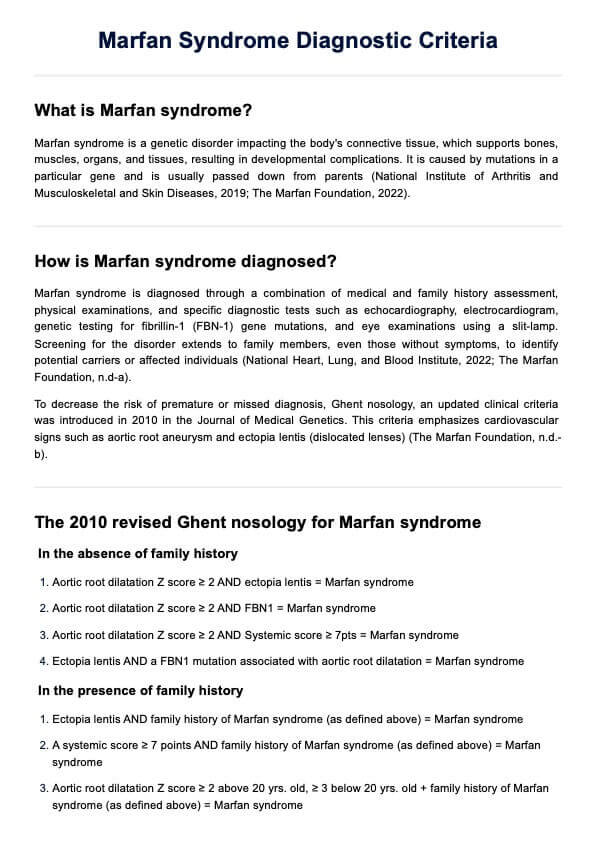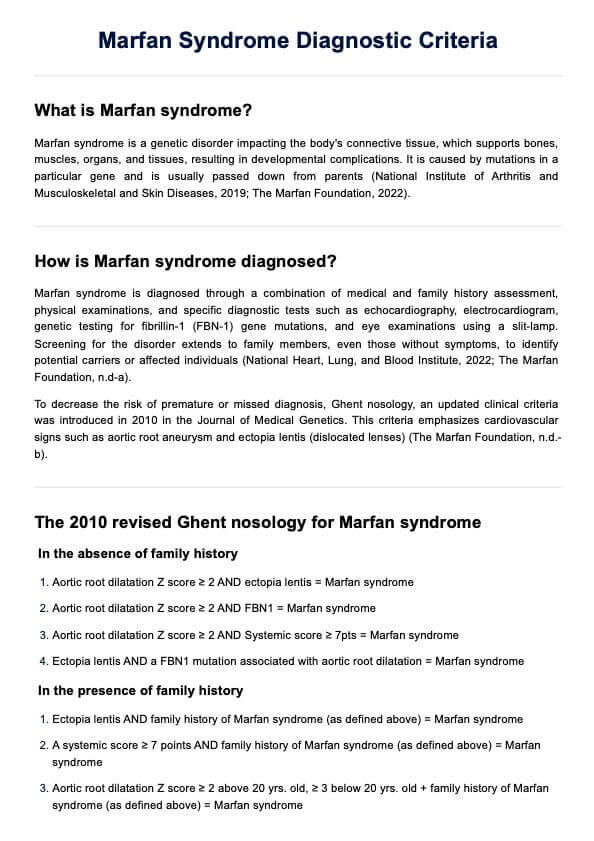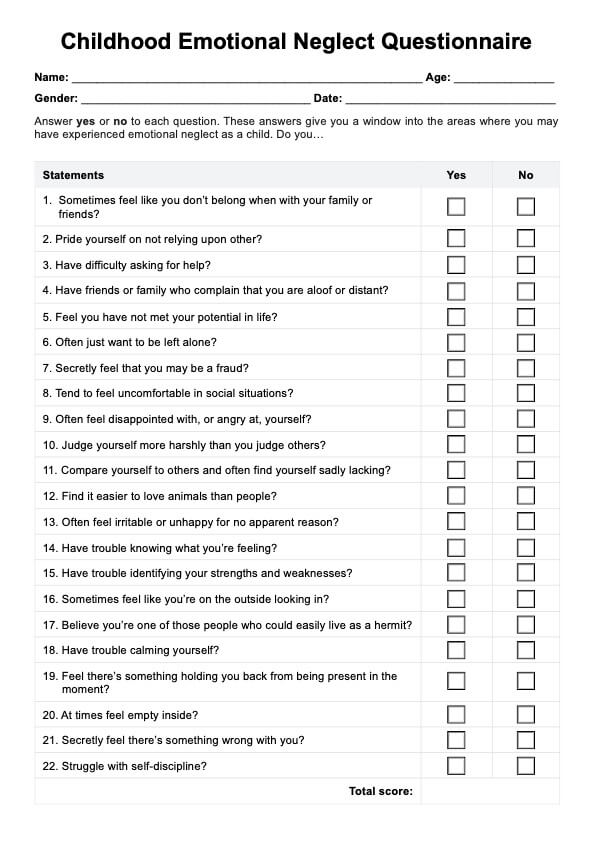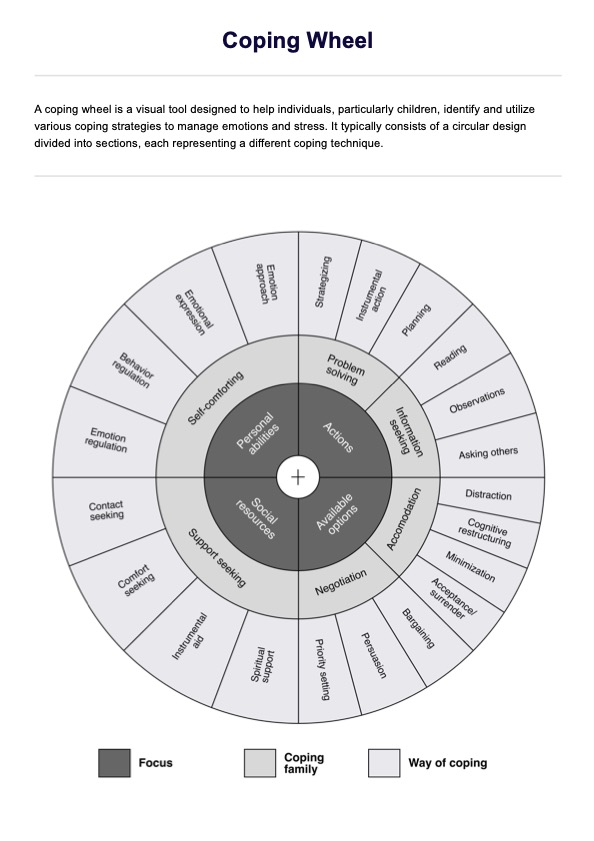Marfan Syndrome Diagnostic Criteria
Improve diagnoses and care for patients with Marfan syndrome using our Marfan Syndrome Diagnosis Criteria.


What is Marfan syndrome?
Some individuals have physical features such as a chest that sinks in or sticks out, a long head with deep-set eyes, a tall and thin body structure, flat feet, and elongated limbs and digits. These physical traits can indicate Marfan syndrome.
Marfan syndrome is a genetic disorder that impacts the body's connective tissue, which supports bones, muscles, organs, and tissues. It results in developmental complications caused by mutations in a particular gene (fibrillin-1 or FBN1), a protein crucial for building elastic fibers. Seventy-five percent of people with Marfan syndrome inherit it from their parents (National Institute of Arthritis and Musculoskeletal and Skin Diseases, 2019; The Marfan Foundation, 2022). When not passed down, it usually results from a random mutation during a baby's development.
Marfan syndrome affects males and females equally worldwide, with an estimated prevalence of 1 in 5,000 to 10,000 individuals in the general population (National Organization for Rare Disorders, 2021). This emphasizes the importance of awareness and early detection for effective management and treatment.
Syndrome Diagnostic Criteria Template
Syndrome Diagnostic Criteria Example
Signs and symptoms of Marfan syndrome
Marfan syndrome may also manifest in cardiovascular, skeletal, and ocular complications. The aorta, a large blood vessel that carries blood from the heart to the rest of the body, is often affected in individuals with Marfan syndrome and usually has problems with their heart and blood vessels. Features can appear at any age, with some present at birth and others, like aortic aneurysm and aortic valve issues, developing later. These features may also worsen over time, leading to aortic dissection.
Here are some of the more visible features of Marfan syndrome:
- Long arms, legs, fingers, and toes
- Flat feet
- Flexible joints
- Tall, thin body
- Curved spine
- Stretch marks unrelated to weight changes
- Chest that sinks in or sticks out
- Long head with deep-set eyes
- Crowded teeth
Less visible signs of Marfan syndrome include heart palpitations, irregular heartbeats, and heart murmurs. Additional symptoms include eye problems, such as blurred vision or trouble seeing distant objects due to a dislocated lens, sudden lung collapse, severe nearsightedness, retinal detachment, early glaucoma, and cataracts.
Diagnosing people with Marfan Syndrome
To diagnose Marfan syndrome, a combination of medical and family history assessment, physical examinations, and specific diagnostic tests such as echocardiography, electrocardiogram, and eye examinations using a slit-lamp are performed (National Heart, Lung, and Blood Institute, 2022; The Marfan Foundation, n.d-a). When clinical evaluation cannot suffice, genetic testing may be further conducted to confirm the diagnosis. Screening for the disorder also extends to family members, even those without symptoms, to identify potential carriers or affected individuals.
The Ghent nosology, an updated clinical criteria introduced in 2010 in the Journal of Medical Genetics, is also used to make a more accurate diagnosis. This emphasizes cardiovascular signs such as aortic root aneurysm and ectopia lentis (dislocated lenses) (The Marfan Foundation, n.d.-b). It outlines the criteria based on the presence and the absence of family history. Systemic score is also calculated by evaluating various features or components.
Diagnosing Marfan syndrome can be complex due to its variable presentation and the need to consider multiple criteria and test results.
How will a diagnosis criteria template help healthcare providers?
A diagnosis criteria template can greatly assist healthcare providers in accurately identifying and confirming medical conditions. Specifically, it can:
Promote accurate diagnosis
With a diagnostic criteria template, healthcare providers can thoroughly consider all symptoms, signs, and test results, ensuring consistent and accurate diagnoses.
Make diagnosis faster
Templates guide providers through essential criteria, making the diagnostic process more efficient. This saves time and helps healthcare teams reach diagnoses quickly and confidently.
Supporting learning and growth
Diagnosis criteria templates are beneficial learning tools. They provide a clear structure for understanding diagnostic criteria, helping healthcare professionals build their skills and feel more confident in their diagnoses.
Next steps after diagnosis
It can be disconcerting for someone when they are diagnosed with Marfan syndrome. Treating Marfan syndrome can be challenging, but after diagnosis, the following can be done:
Regular medical check-ups
Advise your patients to schedule frequent visits with specialists, including cardiologists, to monitor and manage heart valves and the integrity of the aortic wall. This will lower blood pressure and prevent complications associated with Marfan syndrome.
Medication adherence
Emphasize the importance of following prescribed medications consistently to control symptoms and prevent complications related to Marfan syndrome, such as cardiovascular issues and skeletal problems.
Lifestyle modifications
Encourage patients to make necessary adjustments, such as avoiding heavy lifting or strenuous activities, to minimize strain on their body's connective tissues affected by Marfan syndrome. Suggest engaging in low-impact exercises recommended by healthcare providers to promote overall health.
Genetic counseling and genetic testing
For patients who are considering having offspring, recommend genetic counseling to understand the inheritance pattern of Marfan syndrome and its implications for family planning. This can provide insights into the risk of passing the condition to offspring and guide informed decisions.
References
National Heart, Lung, and Blood Institute. (2022, March 24). Marfan syndrome - diagnosis. https://www.nhlbi.nih.gov/health/marfan-syndrome/diagnosis
National Institute of Arthritis and Musculoskeletal and Skin Diseases. (2019, September 30). Marfan syndrome. https://www.niams.nih.gov/health-topics/marfan-syndrome
National Organization for Rare Disorders. (2021, February 5). Marfan syndrome. https://rarediseases.org/rare-diseases/marfan-syndrome/#affected
The Marfan Foundation. (n.d.-a). Getting diagnosed. https://marfan.org/expectations/diagnosis/
The Marfan Foundation. (n.d.-b). Summary of diagnostic criteria. https://marfan.org/dx/rules/
The Marfan Foundation. (2022). Marfan syndrome. https://marfan.org/conditions/marfan-syndrome/
Commonly asked questions
Marfan syndrome is diagnosed through a combination of a detailed medical history, physical examination, genetic testing, and imaging tests like echocardiograms to check for features of the condition.
Before proper interventions and surgical procedures were available, the life expectancy for people with Marfan syndrome was 30-40 years, but with modern medical care and regular monitoring, it can extend to 70 years or more.
Marfan syndrome can appear at any age, with some symptoms present at birth and others developing later in childhood, adolescence, or adulthood.
Marfan syndrome is treated carefully by specialized physicians such as cardiologists, ophthalmologists, and orthopaedists. Treatment options include physical therapy, surgery, and lifestyle adaptations.







































































































